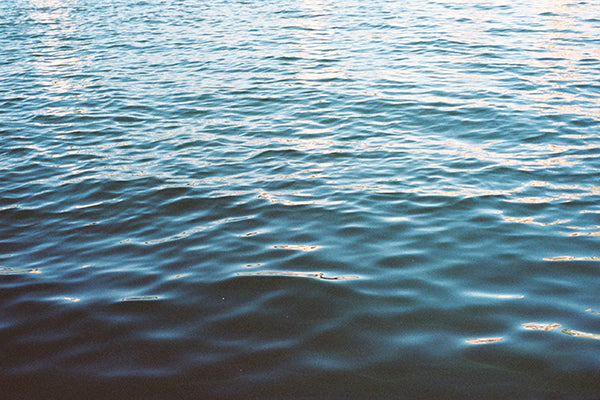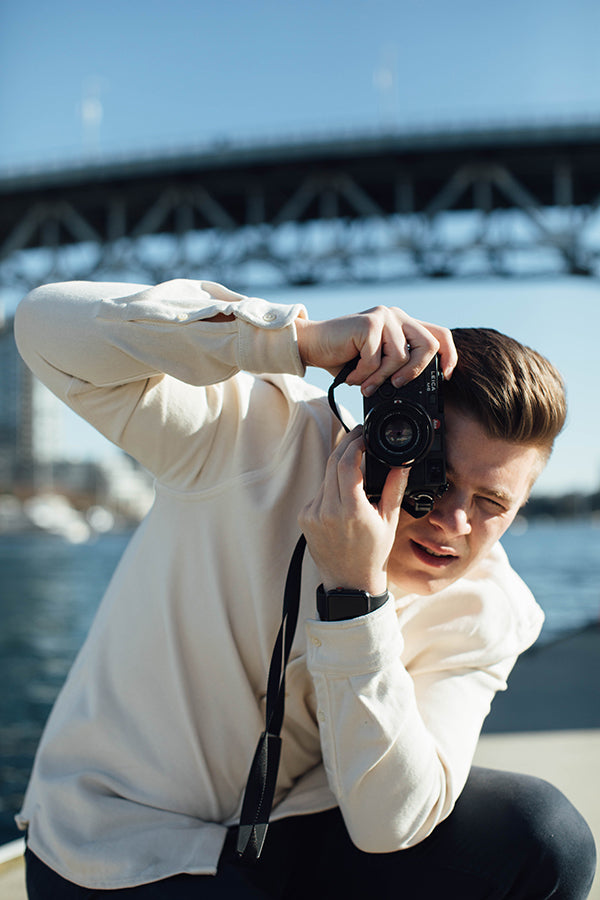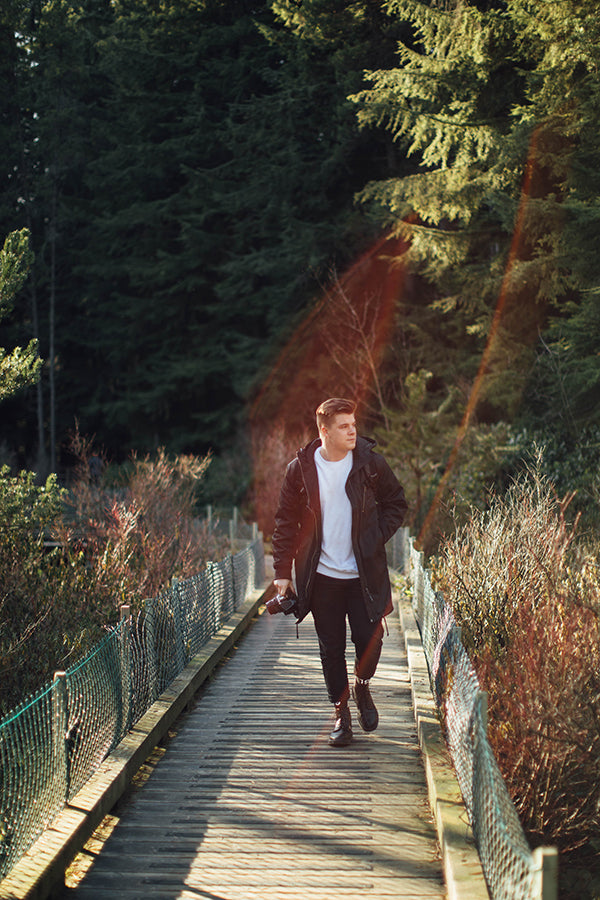Creative Pioneer | Dylan Maranda Posted on 23 Apr 23:55 | Creative Pioneers
This is Dylan Maranda -
a Canadian director based out of Vancouver. Dylan has always been someone that has inspired us with his drive, his kindness, and his unique perspective that shows up in his work. We are humbled to have him be a part of the community and now one of our Creative Pioneers representing the brand. Over the next six months, we'll share content that we have collaborated on, captured through his lens.
Photography by Jeremy Jude Lee and Dylan Maranda
Words by Courtney Chew and Dylan Maranda
MG: Let's start off with five quick things about yourself.
DM: 1. I am a diehard Vancouverite, my childhood was Spanish Banks, old school spotlights at The Ridge theatre, and the Arbutus Rail train rumbling past our apartment in the morning. My Dad was a chef so I grew up in the kitchen. It was there that I learned the values of hard work and a relentless and thankless commitment to the craft. Along with an immense love of food.
2. I was an actor before I was ever a director. I was in theatre companies from when I was 8-18. I constantly reach back to this part of my life when communicating with and directing actors to remember what it’s like to be in that vulnerable position.
3. My parents made sure I had a camera in my hand from an early age, whether it was taking pictures or making short movies with friends or myself.
4. I draw influence from all types of contemporary media. Photography, music, performance, and design are all things that are ready to influence a work of motion picture. I think staying up to date on contemporary work across all platforms is essential to creating relevant work in today’s world.
5. I recently joined the roster at KIDDO, a new-school production company founded and run by Leah Nelson, co-founder of Giant Ant, and Michael Milardo, former ECD at Cossette.

Maranda’s childhood home by Maranda, shot on his Pentax.

Maranda by Jeremy Jude Lee
MG: You’re a filmmaker and most notably, a director. What drove you to focus your talents on directing?
DM: I think it was somewhat of a progression on the basis that I had built from my days as an actor. In my first few years of film school, my intention was actually to go into cinematography. While I have an immense love for image and the process of photography, I think I realized that my strengths were rooted more towards that of direction. Although, the time I took to explore cinematography left me with an invaluable understanding of a more technical department and allowed me to meet some awesome cinematographers that I now get to work with as a director.

LA by Maranda, shot on his Nikonos

Nikonos by Jeremy Jude Lee

Room, shot by Maranda on his Nikonos

Maranda by Jeremy Jude Lee
"I would love my impact to be to hold that door open for those that have been held back by this older structure of production."
MG: You’re a young director living in today’s complex and dynamic world, but in an industry that is slowly adapting to modern standards. Do you ever think about the impact that you want to leave on the industry, and on the even younger generation that follows you?
DM: I think as a young person in the commercial film industry it’s easy to see that the landscape is definitely changing in regards to the system of production that has existed for creating content thus far. I think that this change to a more grassroots industry has opened the door for someone like myself to get opportunities in that direction, which would have been much harder to get even 5 years ago. So, I would love my impact to be to hold that door open for those that have been held back by this older structure of production and to support fellow young people, women in film and the next generation of filmmakers take that next step in their careers, as my mentors have done for me.

The Ridge, shot by Maranda on his Pentax

Maranda by Jeremy Jude Lee

Dylan Maranda
MG: We’re living in an instantaneous, noisy, overwhelming world driven by the powers of social media and the efficiency of technology. Content is all around us, with Millennials being the main audience that everyone is fighting to attract and where ‘thumb-stoppers’ on social media is a measurement of engagement. Now, more and more, we’re seeing real people and real stories becoming important in content that resonates. What is your role in storytelling? Do you feel that your experience and even your cultural background influence the stories that you feel you can tell and share?
DM: Gotta love that term “thumbstoppers” eh? Personally, I feel that the demographic of people like myself in their early 20s have built up a resistance to classical advertising. It’s becoming more important for brands and companies to produce content that provides something of value to their consumers. I think that this criteria of value can be interpreted in several ways, but something that I think exists in all good contemporary commercial work is that it is culturally resonant. “Thumbstoppers” do not matter when people are bombarded with advertising the way that they are now on a daily basis. I think the only way to make an impact on your viewer is to get them to feel something. I think my role as a director constantly shifts depending on the project. Sometimes I am embracing and collaborating on someone else’s creative, sometimes I act almost as a liaison for someone else’s story, and sometimes I am in a position where the entirety of the creative is my responsibility. My role is really to be ready for whatever comes my way.

Ocean, shot by Maranda on his Leica

Maranda by Jeremy Jude Lee

Maranda by Jeremy Jude Lee
"It costs nothing to be kind."

Granville Island, shot by Maranda on his Leica

Maranda by Jeremy Jude Lee
MG: Community is a core part of what we stand for at Mr. Gray. What does that mean to you and how do you commit to giving back to yours?
DM: I think being kind to and supporting others in the film industry is essential in a city where the film community is so small compared to other major cities. The most important reason I have been able to progress in my career is through the support and sharing of knowledge from others. I try to be as open as possible for those who are seeking to learn more about anything film related, making time to talk and share anything I have of value to those who are in an early stage in their career. Commercial filmmaking is an incredibly competitive industry and it’s easy to get caught up in ego. It costs nothing to be kind.
MG: Vulnerability is essential in filmmaking. How do you facilitate openness in your subjects? Is there a favorite moment you remember you captured that related to having a subject be truly vulnerable?
DM: I think to access a place of vulnerability you have to meet actors and subjects in the middle. Whether that means you have been vulnerable as a writer in the script or being vulnerable enough to see things from a subject’s point of view. As a director, reaching a place where that actor or subjects feel safe to express themselves is imperative to the final product. Some people want to be pushed, others want to get there on their own, but I think the key to both is having enough time to allow for the process.
I remember during an interview with a designer for a piece on their brand, they opened up about an incredibly moving story of how he had saved the life of his friend from drowning. It had nothing to do with the subject of the spot, but the difference in tone and content we got after they had shared that story was night and day. By having enough time to explore things outside the subject or narrative at hand, it opened doors to things that we might not have gotten if that subject hadn’t have felt as comfortable as they did after sharing that moment.

Granville Island, shot by Maranda on his Leica

Maranda by Jeremy Jude Lee

Granville Island, shot by Maranda on his Leica

Maranda by Jeremy Jude Lee

Maranda by Jeremy Jude Lee

Forest, shot by Maranda on his Pentax

"I look up to any Creative Pioneer that has truly developed their own voice as an artist."

Maranda by Jeremy Jude Lee
MG: Who is a Creative Pioneer that you look up to? Either from the past or present or both? Who is someone we should interview next?
DM: I look up to any Creative Pioneer that has truly developed their own voice as an artist. I have immense respect for people that have built a body of work where you can look at something like a photograph or listen to a song or watch a spot and know exactly who it is before someone needs to tell you. I think it’s even more impressive when this is achieved by someone young, it would make for an interesting interview.

Maranda by Jeremy Jude Lee

Beach, shot by Maranda on his Leica
MG: Do you have an organization that comes to mind when you think of what it means to embody supporting Creative Pioneers and innovators in the world?
DM: TIFF (Toronto International Film Festival) is more than just a festival. TIFF actively involves itself in a variety of programs that share the empowerment of filmmaking. From outreach programs for youth, the elderly, those suffering from mental health issues to their program “Share Her Story”, an unprecedented commitment to getting more women behind and in front of the camera. These types of programs actively support those who are working towards being the Creative Pioneers of tomorrow.

Chinatown, shot by Maranda on his Leica

Maranda by Jeremy Jude Lee
"Being a Creative Pioneer means constantly striving for the progression of your creative field."
MG: What does it mean to you, to be a Creative Pioneer? What responsibility does that hold for you if anything?
DM: I think being a Creative Pioneer means a constant striving for the progression of your creative field. There is a responsibility to your craft to push into uncharted territory. I think personally, I have a responsibility to push myself. It’s something that is taxing but is integral to creating significant work, and I try to do it every day.